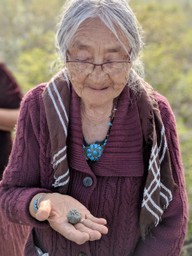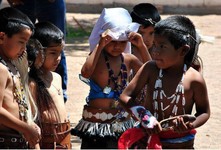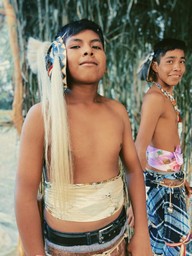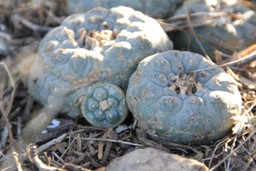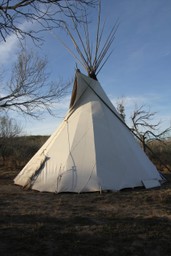Indigenous sovereignty and plant medicines are the core focus of the work of the Riverstyx Foundation, along with their partnered projects: the Indigenous Peyote Conservation Initiative and the Indigenous Medicine Conservation Fund. Join Miriam Volat, MS and Cody Swift, MFT, as we learn about the life-affirming support for Indigenous-led conservation of plant medicine ways.
Getting to Know Cody & Miriam
Cody Swift, MFT
T. Cody Swift, MA, MFT received his degree in existential-phenomenological psychology and brings over 13 years working in the field of psychedelic research. He has served as a therapist-guide in the Johns Hopkins psilocybin and cancer-anxiety trials as well as developed qualitative inquiries into the subjective aspects of participant’s experiences with psilocybin and MDMA. Through the Riverstyx Foundation, he has also worked over 5 years supporting Indigenous communities in the conservation of their sacred plant medicines, as with the Native American Church in the preservation of Peyote.
Miriam Volat, MS
Miriam serves as Co Director with Cody Swift of the Riverstyx Foundation, Interim Executive Director of the Indigenous Peyote Conservation Initiative, Director of the Indigenous Medicine Conservation Fund, and on the Board of Directors of MAPS Public Benefit Corporation. The RiverStyx team undertakes deeply engaged relational philanthropy supporting social justice; ethical and innovative integration of the psychedelic movement into broader society; addressing mental, spiritual, and ecological crises through biocultural responsibility; and respectful allyship with Indigenous traditional knowledge holders.
Miriam works personally and professionally to promote health in all systems. Her background is as a complex systems-facilitator, soil scientist, educator, and community organizer. Her work aims to increase broad-based community and ecological resilience through supporting high leverage initiatives at the intersection of biological, socio-cultural, and psycho-spiritual diversity.
Riverstyx Foundation Mission for Indigenous Sovereignty and Plant Medicines
The Riverstyx Foundation does deep work, investing in a practice of right relationship to make positive change psychospiritually, bioculturally, within society, and in support of Indigenous sovereignty and plant medicines. Cody began to lead the Riverstyx Foundation in 2007, bringing in the knowledge from his psychology degree and the inspiration of his first pivotal psilocybin mushroom experience.
“I was just so amazed by how incredible of a tool it could be for understanding the nature of the mind and the relationship between the mind and reality. It led me down this incredible rabbit hole of finding my way to Johns Hopkins University. They were just launching [an] early trial giving psilocybin mushrooms to cancer patients to help them alleviate the fear and anxiety that was coming up relative to their cancer and facing mortality. It gives people an opportunity to experience themselves and life beyond the construct.
It was so interesting that this research has started again, especially at an esteemed institution like Johns Hopkins and that they were taking the risk and the lead to do this research. I knew I had to help any way that I could, so I [was able to] provide funding for that research. We were still all sort of cautiously optimistic, and seeing over and over these incredible transformations led us to really commit more and more deeply to funding and the movement. And I think we’ve given close to over $10 million over the last 13 years to support the ongoing research with Heffter and MAPS.”
“About seven or eight years ago, I felt kind of a shift in the movement and there was a lot of new funding and interest coming in. During that time, I met an elder, who at the time was the president of the Native American Church of South Dakota, Sandor Iron Rope…[The Native American Church or NAC] is a religion and an organizing party and over a quarter of all Native Americans in the United States have some involvement in the NAC.
They use Peyote as their primary sacrament ritually, which is a mescaline-containing cacti…From the beginning of working in this foundation, I’ve always longed to do some work with Native American communities. I’ve always been aware since I was a young kid of the traumas, the genocides, the great cultural extermination that has taken place within Native American communities. I really struggled over a year to find a strategic and leveraged way that would actually be supportive of those communities.
It’s difficult to find inroads into those communities and to build trusted partnerships in a way that can actually be effective. Eight years ago, I think that the Native American Church was just coming into a recognition that their sacrament was threatened, and that there was a real conservation concern. So, there was this openness and recognition that they needed partnership and support.”
“So that was the birth of our involvement in this. It’s taken a lot of trust-building, a lot of patience, and a lot of continued showing up. Frankly, there’s been a lot of distrust in our intentions, why we’re getting involved in this, and what our intentions are with Peyote. We just have to continue to show up in our greatest integrity and really listen to the Native American elders and what they need.
We’ve built trust to the point where we’ve purchased 600 acres of conservation land in Southwest, Texas, and gifted that to the Indigenous Peyote Conservation Initiative, which is led by a board of all Indigenous elders.”
The Psychedelic Movement, Indigenous Sovereignty and Plant Medicines
Miriam & Cody work regularly to center Indigenous sovereignty and plant medicines, and especially Indigenous medicine keepers and communities, in conversations held throughout the psychedelic field. As Miriam shares, it’s vital that psychedelic decriminalization “happens in such a way that they don’t do harm to Indigenous plant medicine communities. [This includes doing] benefit sharing and supporting Indigenous sovereignty.
One of the phrases that we use a lot is right relationship…Sometimes we don’t think of psychedelics as being [part of] mainstream society, but really there is this mainstreaming of the use of these medicines to address mental health crises, to address the crisis of meaning…that people are really seeking.
We’re really looking at how that can flourish and go forward without negatively impacting Indigenous sovereignty and the ecologies, territories, cultures, and communities on the ground that have relied on their plant medicines for thousands and thousands of years.”
As we have this kind of healing revolution happening, how do we ensure that traditional knowledge holding communities have those biological and cultural heritage rights? Indigenous knowledge holders want to ensure their medicines are here hundreds of years from now. And they want to be in charge of leading their cultural, biological and territorial conservation efforts. For the [psychedelic] renaissance to be successful, we actually have to be in right and ethical relationship with these communities, otherwise we’ve missed a core opportunity for healing.
“What we’re finding to be really important is how this mainstreaming interfaces with these traditional knowledge communities? One thing that we have talked about with pharmaceutical companies that are interested in doing things in an ethical way is that there actually are international protocols – the Nagoya Protocols and the Biodiversity Protocols – that exist within the UN framework.
There’s 176 countries that have signed onto those protocols. They took over 35 years to develop with many, many, many Indigenous leaders from all over the world. We use [these] as a guide because when you have cultural knowledge or biological heritage…what is appropriate is to do both consent work and benefit sharing work…It means that as the psychedelic movement moves forward, it behooves us to really consider how to listen to Indigenous traditional knowledge-holding communities about what they feel is appropriate, what they feel is important.”
“And equally important to that consent and consultation piece – which is very difficult to do and takes time to do – is benefit sharing. We’ve created this Indigenous Medicine Conservation Fund to [be a] vehicle that can do benefit sharing. If you are using something with cultural significance in a way where you get some benefit from it, like a pharmaceutical company in the clinical field, under the Nagoya Protocols, [the company] is responsible to do benefit sharing with traditional knowledge holders.
There’s a lot of potential to do this in a really, really good way. As we have this kind of healing revolution happening, how do we ensure that traditional knowledge holding communities have those biological and cultural heritage rights? Indigenous knowledge holders want to ensure their medicines are here hundreds of years from now. And they want to be in charge of leading their cultural, biological and territorial conservation efforts.
For the [psychedelic] renaissance to be successful, we actually have to be in right and ethical relationship with these communities, otherwise we’ve missed a core opportunity for healing.” This focus on supporting Indigenous sovereignty and plant medicines is the core goal of the IMCF.
Indigenous Peyote Conservation Initiative
The Riverstyx Foundation also supports specific projects focused on Indigenous sovereignty and plant medicines. The Indigenous Peyote Conservation Initiative is an Indigenous-led effort empowering Indigenous communities to reconnect with, regenerate, and conserve their sacred Peyote medicine. This effort came out of a pair of realizations.
As Cody shares, “We’re starting to understand that these medicines have remarkable healing potential, and that’s becoming validated in the Western ethos by these esteemed universities. So, there’s this moment of understanding the power of these medicines, but at the same time, realizing that there are communities who have used these medicines for hundreds, if not thousands of years and have intact cultural norms, rituals, and containers that they’ve evolved over all these years to appropriately hold these medicine experiences within their culture.
And then further realizing that Native American communities are suffering. Their suffering isn’t something of the past, but those traumas continue to reverberate and continue. A shocking statistic that continues to disturb me is that the average life expectancy of Native Americans in the United States is in the mid-50s. Their life expectancy is roughly half of what we expect for white communities. And I think that’s just atrocious. The diabetes, alcoholism, suicide…and these communities need desperately need support.
So, there’s this moment of recognizing that these medicines are powerful healers. These communities are already using them and what they need most is support and strategic thinking on how to ensure that they have continued access to that medicine. And that’s what they want most.”
Follow your Curiosity
Sign up to receive our free psychedelic courses, 45 page eBook, and special offers delivered to your inbox.“Listening to what they needed led to IPCI starting to fund an effort to bring people down to Texas and start figuring out what the situation is down there, and realizing that we needed to start building a robust conservation strategy. IPCI purchased 600 acres, which is a foothold in what has been called the black box of the southwest Texas ranching situation.
Something we didn’t anticipate is that one of the most important conservation strategies actually doesn’t look like conservation from a scientific perspective. It’s been, first and foremost, giving the Native American Church a place that they can call home.
A place in the medicine gardens for the first time where they can go and feel safe, being on their knees, praying to their holy medicine in the ground, as it grows with the sun and the rain, and having a place to commune with their medicine again.
From our Western perspective we thought ‘we need to build this many greenhouses to yield this many Peyotes a year,’ but it’s been a very different approach to really getting behind the Native American communities and really understanding this prayerful relationship to the medicine in the ground and being able to harvest it from a spiritual perspective.”
Miriam adds, “We hear a lot of really wonderful stories about [the old days]. Whole families used to travel from wherever they were – Montana or Oklahoma, New Mexico, Arizona – they would essentially pilgrimage down into south Texas.
They had relationships with ranchers who were the landowners that were really positive and constructive. They would come onto the land and spend a couple of weeks harvesting medicine for healing ceremonies that they knew were going to happen…and bring that medicine back to their families, back to their communities.
But when the DEA got involved in regulating what was happening with the medicine, they gave licenses to distributors, called peyoteros, who were then the only ones who were allowed to actually do that harvesting, distribution, and sales. The distribution of the medicine turned into a commercial enterprise [owned by] just by a few people.
And as often happens when things become commercialized, there is starting to be over-harvesting and poaching. This process of regulation really created a separation between the Native American Church and ABNDN…that led to not just the medicine being harvested improperly, not just the poaching, but their communities not knowing where the medicine comes from and not having that connection to the lands, to the pilgrimage process, to the inter-generational transfer of knowledge that happens when you’re really tending your own medicine, and therefore your spiritual life and your way of life.”
Something we didn’t anticipate is that one of the most important conservation strategies actually doesn’t look like conservation from a scientific perspective. It’s been, first and foremost, giving the Native American Church a place that they can call home. A place in the medicine gardens for the first time where they can go and feel safe, being on their knees, praying to their holy medicine in the ground, as it grows with the sun and the rain, and having a place to commune with their medicine again.
“A lot of what IPCI focuses on is that reconnection – through youth programming, pilgrimage, conversations and knowledge about the life cycle of the medicine, preserving traditional songs and instruments.
We also have a culturally appropriate, [DEA-approved] nursery that took four years to design as a collaboration between folks who know about propagation at scale but also with traditional knowledge holders and elders. We will be on leases that we have with private landholders and ranchers who’ve chosen to go back to the older ways of having relationships with Native American Church members.
We will be doing training and ecological harvest, elders will be coming in and retraining youth and doing spiritual harvest. Then, we will be replanting [babies from the nursery] into the habitat in places that have been over harvested.
Cody highlights that, “…without intervention, Peyote could be harvested to extinction within 20 years. We can’t let that happen. Both from an ecological, botanical, perspective, but also from this cultural perspective too. And these strategies we believe will really help reverse the tide on that: growing the Peyote to about three years old in nurseries and then repopulating the gardens, ensuring that all harvesting has been done in a regenerative way. If you cut the Peyote just right, it will actually regrow and multiply.”
Miriam says, “One of our board members…I’ve heard him say that for Native Americans, we’ve had our land taken away, our children taken away, our access to our food taken away. And we have this medicine, and it’s our last thing. It’s the thing that we have to give to our grandchildren.
It�’s the thing that we have to support our communities to be healthy into the future. It really does behoove us at this point in history in the United States to just respect how Native American Church and ABNDN people want to navigate working with their medicine.
An example [of respecting Indigenous sovereignty and plant medicines] in decriminalization would be to not include Peyote and to not do anything that undermines the American Indian Religious Freedom Act because that’s a part of our federal government that Native Americans really rely on to protect not just their medicine, but also their way of life.
Anytime when we’re looking at doing legal or policy change around psychedelics, it’s really, really important that we don’t make a move with Peyote, which is the medicine of this land, without having the Indigenous people of this land take the first steps and be the lead.”
Indigenous Medicine Conservation Fund
The Indigenous Medicine Conservation Fund really comes out of the Riverstyx Foundation’s deep work building trusting connections in right relationships with Indigenous leaders, focused on Indigenous sovereignty and plant medicines.
Cody shares, “We began co-funding conversation assessments through our partner ICEERS with the Dr. Bronner’s Family Foundation doing conservation assessments on Ayahuasca, to ascertain what the threats are to these biocultures as well. We all know there is a great proliferation of interest in Ayahuasca as well as Iboga and the ibogaine alkaloid, which is very helpful for those struggling with opiate addition.
There’s a proliferation of clinics in Mexico and Canada using Iboga. We were virtually in the dark in terms of how this demand is affecting the natural habitats, wild populations, and the Indigenous cultures using these medicines. And we found that each are greatly threatened.”
And as often happens when things become commercialized, there is starting to be over-harvesting and poaching. This process of regulation really created a separation between the Native American Church and ABNDN…that led to not just the medicine being harvested improperly, not just the poaching, but their communities not knowing where the medicine comes from and not having that connection to the lands, to the pilgrimage process, to the intergenerational transfer of knowledge that happens when you’re really tending your own medicine, and therefore your spiritual life and your way of life.
“The backdrop of this is really remembering what happened to the Indigenous communities that historically used the Psilocybin mushroom, the Mazatec communities, and talking with Kat Harrison, who is an ethnobotanist who’s worked with those tribes for many, many decades.
We had this experience back in the ‘60s and ‘70s where there was a sudden great expansion of interest in psychedelics in the West – an ungrounded, unfettered, fervent interest – leading to a huge influx of tourism and consumerism down into those regions and basically demolished that cultural heritage.
From what Kat Harrison said, those communities were so appalled with how their medicine was being used that they withdrew and buried the tradition. Now, it’s very, very difficult to find the threads to the original ways that the mushroom was being held and used – their songs and their cultural container.”
“As a result, these communities have had a great deal of loss. But there’s also a general loss for the whole psychedelic movement that we have this great disconnect from the original mushroom traditions. Yes, we’re resurrected new techniques and methodologies…but I would regard that as a great tragedy that we are not connected to the original ways.
The Indigenous Medicine Conservation Fund is creating a platform to bring funds from philanthropists, businesses, entrepreneurs alike who are in the psychedelic movement into trusted partnerships with Indigenous tribes. This is creating an opportunity where funding from the West could meet Indigenous communities on the ground and really create a trusted partnership to ensure that these cultures, ceremonies, languages, and ecological relationships are not again lost like they were with the Mazatec.”
Focusing on repairing harm and investing in self-determination for Indigenous sovereignty and plant medicines is a key step in this healing work.”
As a result, these communities have had a great deal of loss. But there’s also a general loss for the whole psychedelic movement that we have this great disconnect from the original mushroom traditions.
“[With the Fund], Miriam has worked to help create a whole unprecedented governance structure which really places Indigenous voices first and foremost, woven through every decision of the fund – how funds are both raised and deployed in those communities.”
Miriam shares that, “Our conservation committee is made up of community leaders from each of the biocultures that we are directly supporting: Bufo, Peyote, Ayahuasca, [Iboga] and a much more quiet relationship with Psilocybin [due to the sensitivities described above].
We have representatives on our conservation committees from each of those bio cultures, and then we also have technical advisors [For four months, we] deeply worked on the governance structure, the mission, the vision, the language that we use, and basically a map for how the relationships from the biocultures themselves, the communities themselves, work inward towards the decision-making of the fund.
The basis of the fund is these community-engaged assessments where people on the ground asked, ‘What do you need for your culture, and your relationship with your medicine and your territory, to be intact in a hundred years? In 200 years? To have everything that you need to not just protect yourself, but to truly and deeply thrive and have a really good life and an unbroken thread of communicating this precious, traditional knowledge that you have, so that your grandchildren, and your great-grandchildren have it?’
In each of those bio cultures, we now have teams on the ground that make relationships with projects, with families, with individuals, and all granting decisions are made by the conservation committee. [Committee members] actually talk with their spiritual advisors, talk with their elders, talk with their families about everything that’s happening in the fund, the decisions that are being made.
So, we not only have a governance structure where representatives from each of the bio cultures are unequivocally responsible for the decisions. Cody and I, ICEERS, and the Bronner’s, who are also seed funders, are part of the technical team. We don’t actually make the decisions.
In the last several months, while decisions were being made, I didn’t know if a project that I maybe thought was important was going to get approved or not. We literally have an Indigenous-led organization and governance structure to create that real trust on the ground and to ensure that we’re being guided by what the biocultural communities themselves want to see happen. That kind of governance structure is a lot of work. It’s also extremely powerful.”
We literally have an Indigenous-led organization and governance structure to create that real trust on the ground and to ensure that we’re being guided by what the biocultural communities themselves want to see happen. That kind of governance structure is a lot of work. It’s also extremely powerful.
“One of the things that’s coming out is that representatives from the different bio cultures are finding what they have in common. There’s a lot of strength and support in that kind of multicultural unity building.
We’ve looked at projects on the ground that can really bring in deep infrastructure, deep systemic support, to efforts that we’ll be able to continue to grow over the next 10, 20, 25 years to really strengthen the communities.
Many of [these projects] are about accessing territory. A lot of them are about language preservation. A lot of them are about connection between elders and young people to pass on traditional knowledge.
For example, the Yaqui tribe has asked to have a university-led environmental assessment to look at the health of the populations of the toads, so that we can have that data…There’s about 30 projects that have been approved by the conservation committee.
When they’ve been approved, they’ve also been brought back into the community to ensure everybody trusts these organizations to carry forward things for their whole communities.”
“We have 15 million more dollars that we’re hoping to raise this year, and all of those funds will be directed into the communities in those five biocultures…Dr. Bronner’s Family Foundation and Riverstyx Foundation are committed that within the next 18 months or so the Indigenous Medicine Conservation Fund will actually fully launch into being its own organization, have an Indigenous director, and fully be an Indigenous-led organization.”
How You Can Support Indigenous Sovereignty and Plant Medicines
Cody highlights the double-edged sword inherent in this work. “I think there’s this real imperative that we have right now to elevate these conversations and raise awareness about these communities.
A big part of that is frankly fundraising, [for example] working with Michael Pollan with the chapter he wrote in his latest book, This is Your Mind on Plants. He wrote a chapter on mescaline and heavily featured the work with IPCI.
It’s important to bring awareness out, but there’s also a risk that these communities are being exposed. [This exposure] increases the political intensity that a lot of these communities already face. I think one of the most important things that we can all do is become more educated…about these communities, their medicines, and how they’ve been held historically, really learning about the Native American Church, learning about the Bwiti tradition in Gabon….Houston Smith has done some incredible research on a book he wrote regarding the Native American Church.
So, educating and then bringing the conversations to the fore, reminding each other of these communities and the importance of being mindful around the medicines that we consume…really do your research and become informed about what it means to ingest Peyote.
Really listen to the tribes who are strongly and desperately pleading with white people to leave their medicine alone because it is so scarce. That’s not because there’s something wrong with white people. It’s because [Indigenous] medicine is truly facing a conservation threat, and white people have access to psilocybin, LSD, 5-MeO-DMT, 2C-I, MDMA, and all these incredible different compounds, but for the Native American people, it’s firmly in their tradition to use Peyote.
They do not see it as a psychedelic. They do not have access or interest in any other medicines, Peyote is what they have. In deference to those communities, I think it’s imperative that we are really mindful of these ecological and cultural concerns and sensitivities.
Really listen to the tribes who are strongly and desperately pleading with white people to leave their medicine alone because it is so scarce. That’s not because there’s something wrong with white people. It’s because their medicine is truly facing a conservation threat, and white people have access to psilocybin, LSD, 5-MeO-DMT, 2C-I, MDMA, and all these incredible different compounds, but for the Native American people, it’s firmly in their tradition to use Peyote. They do not see it as a psychedelic. They do not have access or interest in any other medicines, Peyote is what they have.
Follow your Curiosity
Sign up to receive our free psychedelic courses, 45 page eBook, and special offers delivered to your inbox.Miriam shares that, “In the long view of time, we are in this moment of the sixth greatest extinction that we’ve had here on this Earth. I do tend to think about how important diversity is to the beauty of this planet and earth that we get to live on.
In 300 years, I want all of this incredible beauty, cultural territories, and medicines to be here. When we’re looking at preserving diversity and biodiversity on the planet, sometimes there are these keystone or crucial members of any community that are really important that we support to continue.
I think these Indigenous traditional medicine communities are that – they are keystone to a healthy future for all of us. Right relationship, respecting [Indigenous] sovereignty, and honoring them is sort of like good manners, that the way to support them being here in many years to come is about supporting [Indigenous peoples] to take the lead.
Learn more about and support this powerful work at the Indigenous Peyote Conservation Initiative and the Indigenous Medicine Conservation Fund.


